 |
 |
Our enthusiastic and extremely knowledgeable perennials team is here to answer your questions and help you choose the best perennials for your situation. There’s always something in bloom for sun, shade, butterflies, birds or deer resistance as well as a variety of bulbs for your space.
Stroll through our time-tested favorites and introduce yourself to the newest varieties. We garden with perennials too; we love them and it shows!
|
52 found, showing page 3 of 4
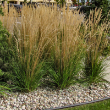
Height: 5 feet
Spread: 32 inches
Sunlight: full sun, partial shade
Hardiness Zone: 3a
Other Names: Feather Reed Grass
Description:
Dramatic red-copper plumes are eye catching during the early to mid summer months; a cool weather performer that looks wonderful in fresh or dried flower arrangements, borders or garden landscapes; heat tolerant and low maintenance
Ornamental Features:
Karl Foerster Reed Grass is primarily grown for its highly ornamental fruit. The tan seed heads are carried on showy plumes displayed in abundance from late summer to late winter. It features bold plumes of brick red flowers with coppery-bronze overtones rising above the foliage in mid summer. Its grassy leaves are green in color. The foliage often turns tan in fall. The gold stems can be quite attractive.
Landscape Attributes:
Karl Foerster Reed Grass is an herbaceous perennial grass with an upright spreading habit of growth. It brings an extremely fine and delicate texture to the garden composition and should be used to full effect.
This plant will require occasional maintenance and upkeep, and is best cut back to the ground in late winter before active growth resumes. It has no significant negative characteristics.
Karl Foerster Reed Grass is recommended for the following landscape applications:
- Vertical Accent
- Mass Planting
- General Garden Use
- Groundcover
- Naturalizing And Woodland Gardens
- Container Planting
- Planting & Growing
Karl Foerster Reed Grass will grow to be about 4 feet tall at maturity, with a spread of 32 inches. It tends to be leggy, with a typical clearance of 1 foot from the ground, and should be underplanted with lower-growing perennials. It grows at a medium rate, and under ideal conditions can be expected to live for approximately 10 years. As an herbaceous perennial, this plant will usually die back to the crown each winter, and will regrow from the base each spring. Be careful not to disturb the crown in late winter when it may not be readily seen!
This plant does best in full sun to partial shade. It is very adaptable to both dry and moist locations, and should do just fine under typical garden conditions. It is not particular as to soil type or pH. It is highly tolerant of urban pollution and will even thrive in inner city environments. This particular variety is an interspecific hybrid. It can be propagated by division; however, as a cultivated variety, be aware that it may be subject to certain restrictions or prohibitions on propagation.
Karl Foerster Reed Grass is a fine choice for the garden, but it is also a good selection for planting in outdoor pots and containers. With its upright habit of growth, it is best suited for use as a 'thriller' in the 'spiller-thriller-filler' container combination; plant it near the center of the pot, surrounded by smaller plants and those that spill over the edges. It is even sizeable enough that it can be grown alone in a suitable container. Note that when growing plants in outdoor containers and baskets, they may require more frequent waterings than they would in the yard or garden.
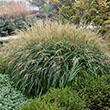
Pinkish blooms. Upright clumping grass. Self-seeding. USDA 5-9
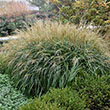
Pinkish blooms. Upright clumping grass. Self-seeding. USDA 5-9
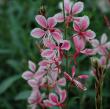
Rose pink blooms on rigid stems. Naturalizing. USDA 5-8 'Siskiyou Pink' prefers full sun and is happy in average to poor, well-drained soil. Wandflower is a tap-rooted perennial so it is very drought tolerant. The tap root makes these difficult to move once they are settled in, so site them carefully.
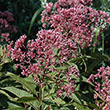
Pink blooms. Tolerates clay & wet soils. Native cultivar. Naturalizing. USDA 4-8
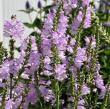
Pink blooms. Compact habit. Slow spreading cultivar. USDA 3-9
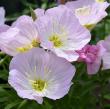
Light pink blooms. Long blooming, easy care plant. Naturalizes quickly. USDA 5-9
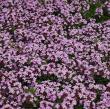
Pink blooms. Fragrant foliage. Evergreen. Moderate foot traffic. USDA 5-8
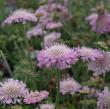
Pale-pink blooms. Long blooming. Compact. Clump-forming. USDA 5-9
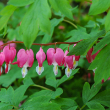
Height: 3 feet
Spacing: 30 inches
Sunlight: partial shade full shade
Hardiness Zone: 1b
Other Names: Old Fashioned Bleeding Heart
Description:
Bushy upright mounded selection features blue-green fern-like foliage and arching stems of heart shaped locket flowers with white protruding petals; excellent for shaded borders and beds; beautiful cut flower; goes into summer dormancy
Ornamental Features:
Common Bleeding Heart features delicate nodding pink heart-shaped flowers with white tips dangling from the stems from late spring to early summer. Its ferny compound leaves remain bluish-green in color throughout the season.
Landscape Attributes:
Common Bleeding Heart is an herbaceous perennial with a mounded form. Its relatively fine texture sets it apart from other garden plants with less refined foliage.
This plant will require occasional maintenance and upkeep, and should be cut back in late fall in preparation for winter. It is a good choice for attracting butterflies to your yard, but is not particularly attractive to deer who tend to leave it alone in favor of tastier treats. It has no significant negative characteristics.
Common Bleeding Heart is recommended for the following landscape applications:
- Mass Planting
- General Garden Use
- Planting & Growing
Common Bleeding Heart will grow to be about 3 feet tall at maturity, with a spread of 3 feet. When grown in masses or used as a bedding plant, individual plants should be spaced approximately 30 inches apart. It grows at a medium rate, and under ideal conditions can be expected to live for approximately 15 years. As an herbaceous perennial, this plant will usually die back to the crown each winter, and will regrow from the base each spring. Be careful not to disturb the crown in late winter when it may not be readily seen! As this plant tends to go dormant in summer, it is best interplanted with late-season bloomers to hide the dying foliage.
This plant does best in partial shade to shade. It prefers to grow in average to moist conditions, and shouldn't be allowed to dry out. It is not particular as to soil pH, but grows best in rich soils. It is somewhat tolerant of urban pollution. Consider applying a thick mulch around the root zone over the growing season to conserve soil moisture. This species is not originally from North America. It can be propagated by division.
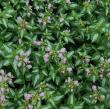
Pink blooms. Green leaves have white diamond. Groundcover. USDA 3-8
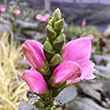
Uniquely shaped, hot pink blooms atop dark green leaves with a bronzy sheen.Best of moist or wet shade. Showy and long lived. USDA 4-9

Height: 22 inches
Spacing: 18 inches
Sunlight: partial shade, full shade
Hardiness Zone: 4a
Other Names: Lenten Rose, Winter Rose
Group/Class: Honeymoon Series
Brand: Proven Winners
Description:
This attractive variety produces bushy mounds of thick evergreen leaves; flower stalks bear showy, cup shaped blooms in shades of pink with purple edges; a great selection for shade gardens
Ornamental Features:
Honeymoon Paris In Pink Hellebore features showy nodding pink cup-shaped flowers with purple edges at the ends of the stems from late winter to early spring. Its attractive serrated oval compound leaves remain dark green in color throughout the year.
Landscape Attributes:
Honeymoon Paris In Pink Hellebore is an herbaceous evergreen perennial with an upright spreading habit of growth. Its medium texture blends into the garden, but can always be balanced by a couple of finer or coarser plants for an effective composition.
This is a relatively low maintenance plant, and should be cut back in late fall in preparation for winter. Deer don't particularly care for this plant and will usually leave it alone in favor of tastier treats. It has no significant negative characteristics.
Honeymoon Paris In Pink Hellebore is recommended for the following landscape applications:
- Mass Planting
- Rock/Alpine Gardens
- Border Edging
- General Garden Use
- Naturalizing And Woodland Gardens
Planting & Growing:
Honeymoon Paris In Pink Hellebore will grow to be about 18 inches tall at maturity, with a spread of 24 inches. When grown in masses or used as a bedding plant, individual plants should be spaced approximately 18 inches apart. Its foliage tends to remain dense right to the ground, not requiring facer plants in front. It grows at a medium rate, and under ideal conditions can be expected to live for approximately 5 years. As an evegreen perennial, this plant will typically keep its form and foliage year-round.
This plant does best in partial shade to shade. It does best in average to evenly moist conditions, but will not tolerate standing water. It is not particular as to soil pH, but grows best in rich soils. It is somewhat tolerant of urban pollution, and will benefit from being planted in a relatively sheltered location. This particular variety is an interspecific hybrid, and parts of it are known to be toxic to humans and animals, so care should be exercised in planting it around children and pets. It can be propagated by division; however, as a cultivated variety, be aware that it may be subject to certain restrictions or prohibitions on propagation.
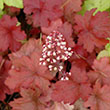
Plant Height: 9 inches
Flower Height: 14 inches
Spacing: 12 inches
Sunlight: full sun, partial shade, full shade
Hardiness Zone: 4a
Other Names: Coralbells, Alumroot
Description:
The reddest foliage in spring turns radiant copper-orange with red veins, returning to red in fall; pink bells in early summer; amazing color addition with great versatility; keep soil moist in heat of summer
Ornamental Features:
Fire Alarm Coral Bells features dainty spikes of pink bell-shaped flowers rising above the foliage in early summer. Its attractive tomentose lobed leaves emerge crimson in spring, turning orange in color with distinctive dark red veins. The foliage often turns crimson in fall.
Landscape Attributes:
Fire Alarm Coral Bells is a dense herbaceous evergreen perennial with tall flower stalks held atop a low mound of foliage. Its relatively fine texture sets it apart from other garden plants with less refined foliage.
This is a relatively low maintenance plant, and should be cut back in late fall in preparation for winter. It is a good choice for attracting hummingbirds to your yard. It has no significant negative characteristics.
Fire Alarm Coral Bells is recommended for the following landscape applications:
- Mass Planting
- Rock/Alpine Gardens
- Border Edging
- General Garden Use
- Groundcover
- Container Planting
- Planting & Growing
Fire Alarm Coral Bells will grow to be about 9 inches tall at maturity extending to 14 inches tall with the flowers, with a spread of 14 inches. When grown in masses or used as a bedding plant, individual plants should be spaced approximately 12 inches apart. Its foliage tends to remain low and dense right to the ground. It grows at a medium rate, and under ideal conditions can be expected to live for approximately 10 years. As an evegreen perennial, this plant will typically keep its form and foliage year-round.
This plant performs well in both full sun and full shade. However, you may want to keep it away from hot, dry locations that receive direct afternoon sun or which get reflected sunlight, such as against the south side of a white wall. It prefers to grow in average to moist conditions, and shouldn't be allowed to dry out. It is not particular as to soil type or pH. It is somewhat tolerant of urban pollution. Consider covering it with a thick layer of mulch in winter to protect it in exposed locations or colder microclimates. This particular variety is an interspecific hybrid. It can be propagated by division; however, as a cultivated variety, be aware that it may be subject to certain restrictions or prohibitions on propagation.
Fire Alarm Coral Bells is a fine choice for the garden, but it is also a good selection for planting in outdoor pots and containers. It is often used as a 'filler' in the 'spiller-thriller-filler' container combination, providing a mass of flowers and foliage against which the larger thriller plants stand out. Note that when growing plants in outdoor containers and baskets, they may require more frequent waterings than they would in the yard or garden.

Plant Height: 7 inches
Flower Height: 14 inches
Spacing: 12 inches
Sunlight: full sun, partial shade, full shade
Hardiness Zone: 4a
Other Names: Coralbells, Alumroot
Description:
Pink bells rise from compact mounds of rose-purple colored foliage with a silver overlay; amazing contrast to other plants; great versatility; keep soil moist in heat of summer
Ornamental Features:
Georgia Plum Coral Bells features dainty spikes of pink bell-shaped flowers rising above the foliage from late spring to mid summer. Its attractive crinkled lobed leaves remain rose in color with showy purple variegation and tinges of silver throughout the year.
Landscape Attributes:
Georgia Plum Coral Bells is a dense herbaceous evergreen perennial with tall flower stalks held atop a low mound of foliage. Its relatively fine texture sets it apart from other garden plants with less refined foliage.
This is a relatively low maintenance plant, and should be cut back in late fall in preparation for winter. It is a good choice for attracting hummingbirds to your yard. It has no significant negative characteristics.
Georgia Plum Coral Bells is recommended for the following landscape applications:
- Mass Planting
- Rock/Alpine Gardens
- Border Edging
- General Garden Use
- Groundcover
- Container Planting
- Planting & Growing
Georgia Plum Coral Bells will grow to be about 7 inches tall at maturity extending to 14 inches tall with the flowers, with a spread of 15 inches. When grown in masses or used as a bedding plant, individual plants should be spaced approximately 12 inches apart. Its foliage tends to remain low and dense right to the ground. It grows at a medium rate, and under ideal conditions can be expected to live for approximately 10 years. As an evegreen perennial, this plant will typically keep its form and foliage year-round.
This plant performs well in both full sun and full shade. However, you may want to keep it away from hot, dry locations that receive direct afternoon sun or which get reflected sunlight, such as against the south side of a white wall. It prefers to grow in average to moist conditions, and shouldn't be allowed to dry out. It is not particular as to soil type or pH. It is somewhat tolerant of urban pollution. Consider covering it with a thick layer of mulch in winter to protect it in exposed locations or colder microclimates. This particular variety is an interspecific hybrid. It can be propagated by division; however, as a cultivated variety, be aware that it may be subject to certain restrictions or prohibitions on propagation.
Georgia Plum Coral Bells is a fine choice for the garden, but it is also a good selection for planting in outdoor pots and containers. It is often used as a 'filler' in the 'spiller-thriller-filler' container combination, providing a mass of flowers and foliage against which the larger thriller plants stand out. Note that when growing plants in outdoor containers and baskets, they may require more frequent waterings than they would in the yard or garden.
52 found, showing page 3 of 4









